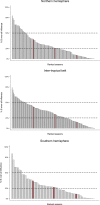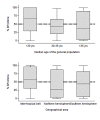The epidemiological signature of influenza B virus and its B/Victoria and B/Yamagata lineages in the 21st century
- PMID: 31513690
- PMCID: PMC6742362
- DOI: 10.1371/journal.pone.0222381
The epidemiological signature of influenza B virus and its B/Victoria and B/Yamagata lineages in the 21st century
Abstract
We describe the epidemiological characteristics, pattern of circulation, and geographical distribution of influenza B viruses and its lineages using data from the Global Influenza B Study. We included over 1.8 million influenza cases occurred in thirty-one countries during 2000-2018. We calculated the proportion of cases caused by influenza B and its lineages; determined the timing of influenza A and B epidemics; compared the age distribution of B/Victoria and B/Yamagata cases; and evaluated the frequency of lineage-level mismatch for the trivalent vaccine. The median proportion of influenza cases caused by influenza B virus was 23.4%, with a tendency (borderline statistical significance, p = 0.060) to be higher in tropical vs. temperate countries. Influenza B was the dominant virus type in about one every seven seasons. In temperate countries, influenza B epidemics occurred on average three weeks later than influenza A epidemics; no consistent pattern emerged in the tropics. The two B lineages caused a comparable proportion of influenza B cases globally, however the B/Yamagata was more frequent in temperate countries, and the B/Victoria in the tropics (p = 0.048). B/Yamagata patients were significantly older than B/Victoria patients in almost all countries. A lineage-level vaccine mismatch was observed in over 40% of seasons in temperate countries and in 30% of seasons in the tropics. The type B virus caused a substantial proportion of influenza infections globally in the 21st century, and its two virus lineages differed in terms of age and geographical distribution of patients. These findings will help inform health policy decisions aiming to reduce disease burden associated with seasonal influenza.
Conflict of interest statement
Clotilde El-Guerche Séblain is an employee of Sanofi Pasteur. She was the coordinator of the research project at Sanofi Pasteur, she helped define the study objectives, and critically revised the manuscript. When reviewing the manuscript, the revisions concerned the epidemiological findings of the study and not the public health findings or conclusions. This does not alter our adherence to PLOS ONE policies on sharing data and materials. Cheryl Cohen has received grant support from Sanofi Pasteur, Advanced Vaccine Initiative, US Centers for Disease Control and Prevention, and payment of travel costs from Parexel. All of the other authors declare that they have no conflict of interests to disclose.
Figures



References
-
- Rolfes MA, Foppa IM, Garg S, Flannery B, Brammer L, Singleton JA et al. Annual estimates of the burden of seasonal influenza in the United States: A tool for strengthening influenza surveillance and preparedness. Influenza Other Respir Viruses. 2018;12(1):132–137. 10.1111/irv.12486 - DOI - PMC - PubMed
-
- Cassini A, Colzani E, Pini A, Mangen MJ, Plass D, McDonald SA, et al. Impact of infectious diseases on population health using incidence-based disability-adjusted life years (DALYs): results from the Burden of Communicable Diseases in Europe study, European Union and European Economic Area countries, 2009 to 2013. Euro Surveill. 2018;23(16). - PMC - PubMed
Publication types
MeSH terms
Substances
LinkOut - more resources
Full Text Sources
Other Literature Sources
Medical

